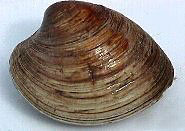Archive:Monthly Write-a-Thon
The Partiers
Howard observes one must not miss the boat in Chatham, Massachusetts, or it will be much more difficult to fish. Yes, it is possible to rake for quahogs in shallow water, but a skiff is a very good idea.
He has been experimenting with restructuring some articles such as Taliban first, and then Iraq War and Afghanistan War (2001-), so there is a sensible and approvable core, from which subarticles can branch for continuing events.
His general challenge is for more engineering articles on tools and fasteners. Go ahead. Folksingers, if you had a hammer, write about it. There is drill besides Monty Python marching up and down the square. Even ignoring the idiomatic use of screw, there are multitudinous additions, if you won't be a nut and bolt. Howard C. Berkowitz
Daniel edited quahog and played around with ways to display its current state :
Quahog is a clam species, Arctica islandica, a mollusk commercially harvested on both coasts of the North Atlantic Ocean. "Quahog" is more the New England term; it is called a "hard-shelled clam" in the waters of the Chesapeake Bay. By either name, it is a slow-growing species, although not overfished; commercial fisheries are subject to Vessel Monitoring System tracking. While individuals over 200 years old have been found, growth slows after 20 years.[1] Even with the long history, the First Annual Cape Cod Quahog Day will take place in 2009.
In ocean waters, they are taken by dredging from the seafloor, although quahogs are also harvested by hand rakes in shallow coastal waters; the latter is a recreational fishery in New England. Ocean dredges, usually called New Bedford style, are hydraulic, using water jets to separate the shells from the ocean floor. They have a cutting bar which rides above the seafloor, pushing objects into the collecting bag. Arrangements of metal rings and chains keep rocks from being pulled into the bag. [2]
Fresh quahogs have an excellent flavor, but freshness is essential unless they are promptly frozen. They will, however, keep well for a week after harvesting, but need to be rinsed in cold water, and then refrigerated and kept on their sides. Discard any that stay open; they are dead. They can be eaten raw on the half shell, but are unpleasantly tough when steamed or fried, they are used in a variety of clam dishes, but aficionados all have a special recipe for baked, stuffed quahog. Chopped, they work well in chowders, sauces, and clam cakes.
To speak of "opening" a quahog marks one as a novice, for whom the task will be a challenge. The proper term is "shucking". Traditionally, it is easiest to shuck a quahog when it has been chilled for several hours. While purists are shocked by the idea, very brief microwaving will also relax the muscle, although it may toughen it slightly. Unless one is very experienced, or enjoys cut hands, a specific clam knife is appropriate. Slide the blade along the inside of one shell, which will cut one side of the two adductor muscles. Open the shell and release the meat by cutting the other side. (Read more...)
- ↑ Larry Jacobson and James Weinberg (December 2006), Status of Fishery Resources off the Northeastern US: Ocean quahog (Arctica islandica), National Oceanographic and Atmospheric Administration
- ↑ David Stevenson et al., 3. Fishing Gear and Practices used in the Northeast Region: Quahog Dredges, NOAA Technical Memorandum NMFS NE 181: Characterization of the Fishing Practices and Marine Benthic Ecosystems of the Northeast U.S. Shelf, and an Evaluation of the Potential Effects of Fishing on Essential Fish Habitat, National Oceanographic and Atmospheric Administration, p. 47
